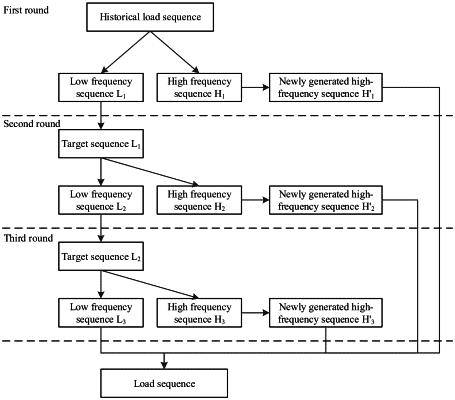| CPC H02J 3/003 (2020.01) [G06Q 50/06 (2013.01); H02J 2203/20 (2020.01)] | 7 Claims |

|
1. A method for forecasting an electric load, comprising:
acquiring historical load data prior to a forecast date, wherein the historical load data comprises load values at a plurality of times;
generating a load sequence based on the historical load data;
performing variational mode decomposition on the load sequence, to obtain a plurality of intrinsic mode components and a residual that are corresponding to the load sequence;
inputting the plurality of intrinsic mode components and the residual into respective forecasting models, and determining a load value on the forecast date based on forecasting results of all the forecasting models; and
controlling an integrated energy management system to start or stop on the forecast date based on the load value on the forecast date;
wherein the generating the load sequence based on the historical load data comprises:
converting the historical load data into a historical load sequence; and
denoising the historical load sequence to generate the load sequence, wherein the denoising the historical load sequence to generate the load sequence comprises:
performing n rounds of decomposition on a target sequence until a cycle ends, wherein the target sequence of a first round is the historical load sequence, and n is the number of the intrinsic mode components; and
generating the load sequence by combining a low-frequency sequence Ln in a last round and high-frequency sequences newly generated in all the n rounds, wherein an i-th round of decomposition comprises: decomposing a target sequence Li-1 of the i-th round into a low-frequency sequence Li and a high-frequency sequence Hi, wherein the low-frequency sequence Li is a low-frequency component of the target sequence Li-1, and the high-frequency sequence Hi is a high-frequency component of the target sequence Li-1; retaining a part of the high-frequency sequence Hi that is not smaller than a preset threshold, and newly generating a high-frequency sequence H′i;
and determining the low-frequency sequence Li of the i-th round as the target sequence in a next round until the cycle ends.
|